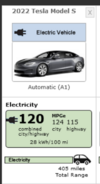If you care about true cost per mile for your Tesla, you also need to take into consideration of phantom drain. Wh/mi figure does NOT take into consideration of the energy it uses when it’s not moving. Significant factors for phantom drain include COP, sentry mode, summon standby, frequent app check, etc. Look at it this way: wh/mi is how much energy it uses when moving, and phantom drain is how much energy it uses when parking.
You can have great moving efficiency, ie, superb wh/mi, but if you park outside for hours and use COP/sentry etc. and do not take these drain into consideration, you will find your total lost kWh since last charge simply doesn’t not add up.
It gets even more tricky, as tesla tucks away a few % of miles as you drive but put it back under 0% as a safety margin. In another words, let’s say you charge to 100%, and drive at the rated wh/mi w/o stopping, you will find you are still “missing miles” as you drive, but ultimately those miles will be given back in the form of reserve under 0%.
Hope this make sense. It certainly confused me when I started as a first time tesla owner back in February also. You can check out one of the old threads I started for more detailed discussion on phantom drain ("Where's the missing 10 kwh energy use from today?")
STATS app tells me my moving efficiency is good (97% efficiency, better than 75% of S owners), but my phantom drain is horrible (better than only 14% of S owners). But I consider sentry mode a must for me - not only for just in case purpose, but every now and then I get a funny clip and can save it for a shared laugh w/ my family (not to mention potential fame on "Wham Bam Tesla Cam" youtube channel).

Oh, and, COP is a must for 100 degree Texas summer too.





